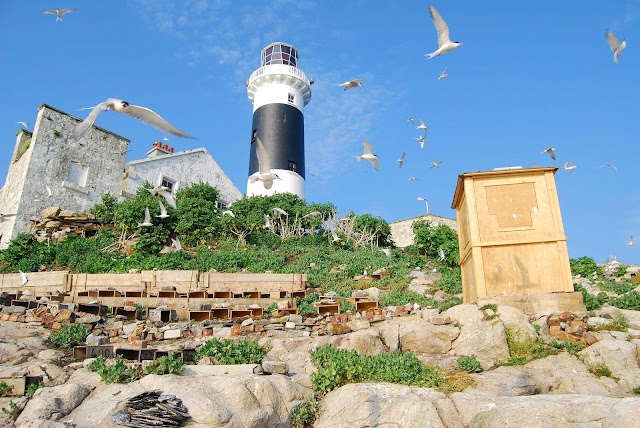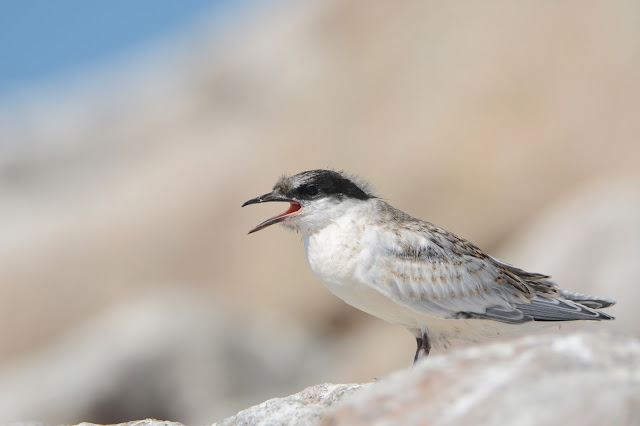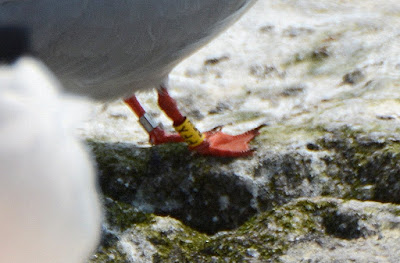Apologies for the major radio silence - the end of the season is one of our busiest times on Rockabill (along with the start of the season, and the middle of the season...) and after that followed our reintegration back into normal society, followed by a couple of weeks of data analysis and report writing! With all of that behind us we're now in a position to tell the story of how the biggest colony of Roseate Terns in Europe got on this year.
 |
| Roseate Terns on Rockabill, Summer 2016. (picture taken under NPWS license) |
Large seabird colonies are all about life and death - Adults have to survive the winter and many undertake epic challenging migrations in the hope of reaching the colony, finding a mate and raising chicks. Many mate and produce eggs, which don't make it to hatching because of predation or harsh weather. Others manage to incubate and protect their eggs long enough for them to hatch, only for the chicks to die somewhere in the month or so it takes for them to grow feathers and begin to fly, again with predation and harsh weather the typical causes. Perhaps most heart-breaking of all is when adults pass all those hurdles of protecting their eggs and raising the chicks until they can fly, only for those fledglings to be predated soon after.
 |
| Roseate Terns early in the 2016 breeding season on Rockabill (picture taken under NPWS license) |
 |
| Roseate Terns on their nestboxes early in the 2016 breeding season Rockabill. (picture taken under NPWS license) |
The Good:
Regular followers of the blog will remember the very pleasant surprise we had in late-June that the number of breeding pairs of Roseate Terns on Rockabill had risen by around 200 pairs to over 1,550. Given that Rockabill holds the biggest numbers in Europe this was a very welcome boost, and together with the work we're doing as part of the EU LIFE funded project with our partners in the RSPB and the North Wales Wildlife Trust it should help us secure they're future in this part of the world over the coming years.
In addition to that, the number of eggs laid by each pair was normal (I mean that in a good way!) and hatching rates were high too. We put out around 750 nestboxes and over 90% were occupied, the highest occupancy we've recorded to date! So there was plenty of good news by the middle of the season.
 |
| Roseate Tern sitting on its two eggs on Rockabill, Summer 2016. (picture taken under NPWS license) |
 |
| Our new ring-reading hide, terracing and nestboxes, Summer 2016. (picture taken under NPWS license) |
 |
| The first Roseate Tern egg on Rockabill in 2016 (picture taken under NPWS license) |
The Bad:
It was around late June when our first Roseate chicks began to hatch, and unfortunately that's where the good news for this season ended. It very quickly became apparent that chick survival was going to be low. In almost all nests with two chicks the younger sibling died within 4 or 5 days. We weigh and measure chicks on a daily basis and this confirmed that growth rates were well below what they should be. During our chick-feeding studies we usually see the older chick getting two thirds of the food, with the younger chick managing to get some when the big chick is full. This year the older chick was never full however and kept competing for any incoming food, at the expense of the smaller chick. Our final tallies revealed that Roseate Tern productivity, i.e. the average number of chicks fledged per pair, was the lowest we've seen it on Rockabill with only 6 or 7 chicks surviving out of every 10 nests. Last year we ringed around 1500 Roseate Tern chicks whereas this year we ringed around two-thirds of that, despite having more pairs breeding this year.
 |
| A 'blonde' Roseate Tern chick on Rockabill, Summer 2016. (picture and handling under NPWS license) |
 |
| Roseate Tern fledgling and parent on Rockabill, Summer 2016. (picture taken under NPWS license) |
The Future:
I started this blog during the 2014 season and anyone following it since then might think this all sounds very familiar. The results of the 2014 season were very similar to 2016. Thankfully last year everything went well and breeding numbers and chick survival were all high. Those good years balance out the bad years, and it's because we've had a lot more good years than bad years that the Rockabill population of Roseate Terns has continued to grow since we started this conservation project in 1989. The frequency of bad years due to lack of suitable fish prey (2 of the last 3) is certainly cause for concern. It doesn't mean next year won't be fine, but how long until we have another bad year again? Were these temporary anomalies in suitable fish-prey numbers in the Irish Sea or are we seeing the start of a larger problem? Only time will tell.
 |
| Roseate Terns gathering on the edge of the colony at the end of the season (picture taken under NPWS license) |
Earlier in the season we knew that Little Terns didn't even attempt to breed at their usual colony at Baltray in Louth, further north in the Irish Sea, and local fishermen commented on the lack of Sandeels in the area. Tern colonies at Dublin Port, Dalkey and Kilcoole all had a poor year too. Issues of predation played a larger part there, but there may have also been a lack of food. Thankfully our colleagues at Tern colonies further afield in the Irish Sea reported good years overall. Long-term and widespread monitoring helps us see the bigger picture not only about our seabird populations, but the ecosystems and species they rely on and exist with. With that in mind we learned a lot in 2016. It'll be interesting to see what 2017 brings!


















































